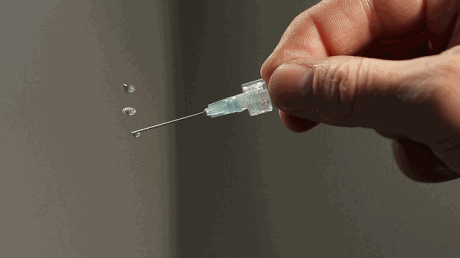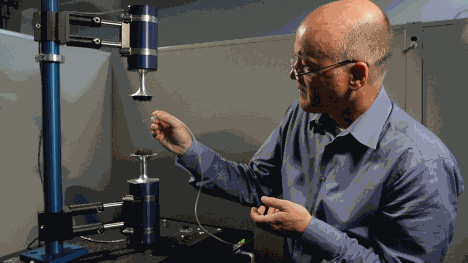The video shows physicist Chris Benmore, who is with the Advanced Photon Source X-ray Science Division at Argonne, suspending droplets of liquid between two speakers that “generate sound waves at frequencies slightly above the audible range – roughly 22 kilohertz,” according to in the online Argonne story on the development.
“When the top and bottom speakers are precisely aligned, they create two sets of sound waves that perfectly interfere with each other, setting up a phenomenon known as a standing wave.
“It’s not a magic trick and it’s not sleight of hand,” the article notes, “scientists really are using levitation to improve the drug development process, eventually yielding more effective pharmaceuticals with fewer side effects.”
Thanks to the video, the Benmore team’s work has been featured on a list of Websites that includes (to name but a scant few) Mythbusters (“Acoustic Levitation Used to Test Pharmaceuticals”) where it was Video of the Week, the CBS News (“‘Glitch in the matrix’ becomes a scientific reality with acoustic levitation”), Wired UK (“'Acoustic levitation' used to develop more efficient drugs”), Scientific American
(where it was Video of the Week for September 20), CNET Australia (“…science wizardry at its best”), Chicago Magazine (“Argonne Scientists Float Drugs in Sound”), NBC News Future Tech (“See sound waves levitate drops of liquid”), New Scientist (“Wingardium leviosa! Wand used to make water levitate!” for you Harry Potter fans), Discover Magazine (“Watch This: Water Droplets Held Aloft by Sound Waves”), Popular Science (“Government Wizards Levitate Drugs with Ultrasonic Sound”), and MSN New Zealand (“Scientists find way to make liquid levitate”), as well as an array of televised newscasts.For a complete rundown of the technique and its potential application, see the Argonne feature story, “No magic show: Real-world levitation to inspire better pharmaceuticals,” which can be read here.
The Advanced Photon Source at Argonne National Laboratory is one of five national synchrotron radiation light sources supported by the U.S. Department of Energy’s Office of Science to carry out applied and basic research to understand, predict, and ultimately control matter and energy at the electronic, atomic, and molecular levels, provide the foundations for new energy technologies, and support DOE missions in energy, environment, and national security. To learn more about the Office of Science x-ray user facilities, visit http://science.energy.gov/user-facilities/basic-energy-sciences/.
Argonne National Laboratory seeks solutions to pressing national problems in science and technology. The nation's first national laboratory, Argonne conducts leading-edge basic and applied scientific research in virtually every scientific discipline. Argonne researchers work closely with researchers from hundreds of companies, universities, and federal, state and municipal agencies to help them solve their specific problems, advance America's scientific leadership and prepare the nation for a better future. With employees from more than 60 nations, Argonne is managed by UChicago Argonne, LLC for the U.S. Department of Energy's Office of Science.


